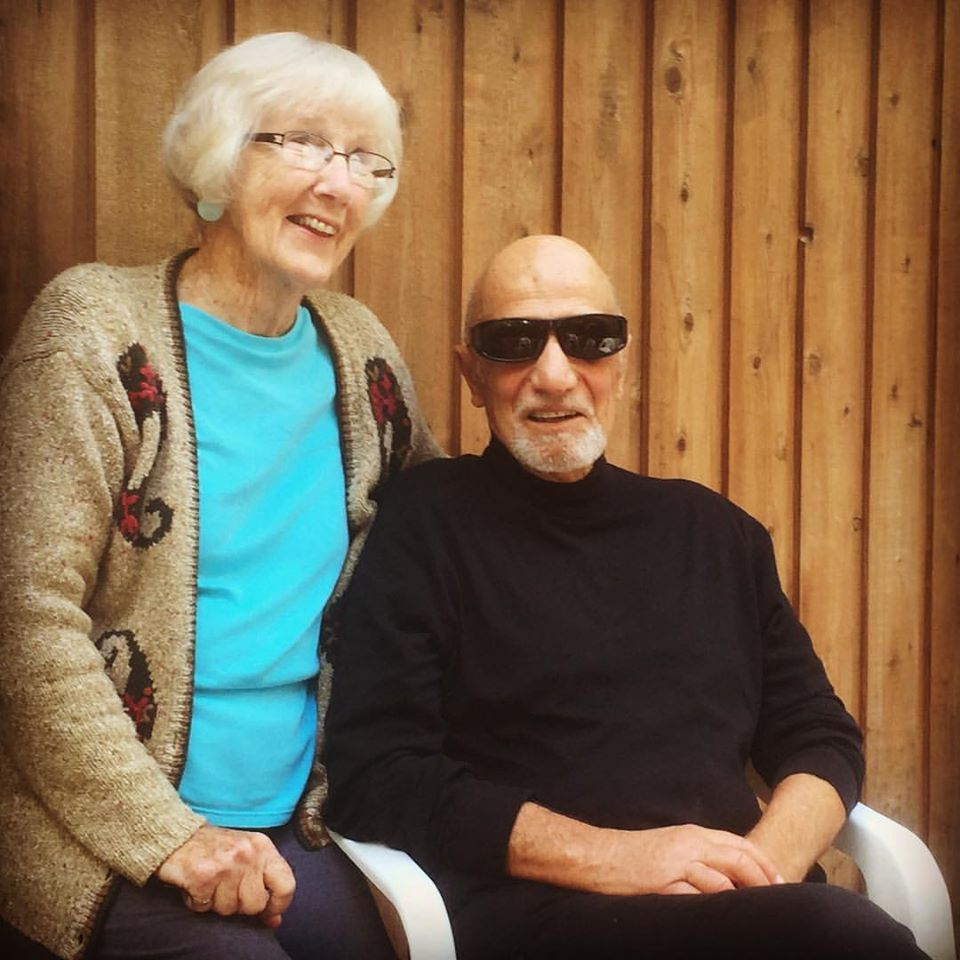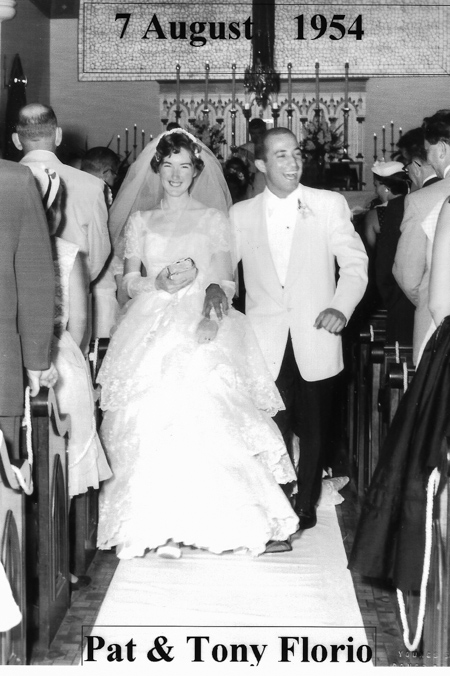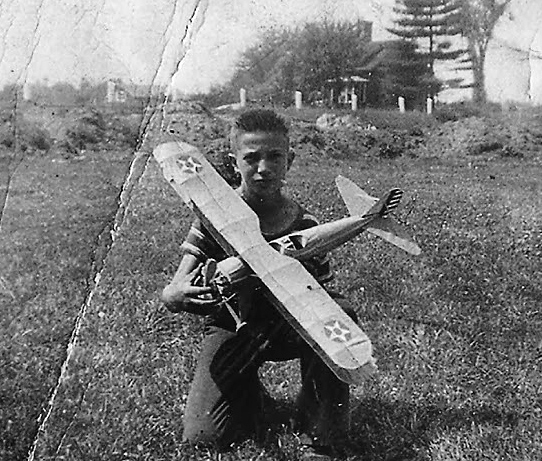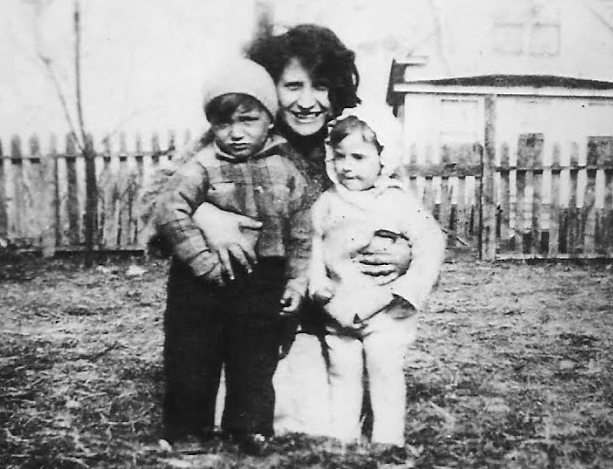Category Archives: Anthony Florio
Woodland Beach Wildlife Area Named for Conservationist and Longtime Wildlife Professional Tony Florio
Smyrna-Clayton Sun News – June 24. 2014
A dedication ceremony Monday honored Florio, who finished his long career as Delaware’s Wildlife Section administrator with the Division of Fish and Wildlife in 1986.
The Woodland Beach Wildlife Area northeast of Smyrna was dedicated on Monday to Tony Florio who retired as the Delaware Division of Fish and Wildlife’s Wildlife Section administrator in 1986. Pictured at the ceremony (from left) are Tony Florio, his wife Pat, and their children, Gwen, Kathleen, and Roger.
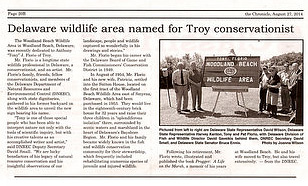 Longtime Delaware wildlife professional, conservationist, writer, and artist Anthony J. “Tony” Florio was honored Monday when the Woodland Beach Wildlife Area where he worked and lived was dedicated in his name.
Longtime Delaware wildlife professional, conservationist, writer, and artist Anthony J. “Tony” Florio was honored Monday when the Woodland Beach Wildlife Area where he worked and lived was dedicated in his name.
Fittingly, Florio, his family, friends, Division of Fish and Wildlife co-workers, and fellow conservationists gathered in Florio’s former backyard at the Thomas Sutton House on the wildlife area to unveil the new sign bearing his name.
Department of Natural Resources and Environmental Control Deputy Secretary David Small and Division of Fish and Wildlife Director David Saveikis joined a host of Division of Fish and Wildlife staff, past and present, at the event. During the ceremony, beneath the blue skies of a perfect summer day, tree swallows darted in and out of a nearby nesting box, feeding their young in front of about 160 guests.
“Tony is one of those special people who has been able to interpret nature not only with the tools of scientific inquiry, but with his creative talents as an accomplished writer and artist,” said Small. “We are lucky benefactors of his legacy of natural resource conservation and his insightful observations of our landscape, people and wildlife captured so wonderfully in his drawings and stories.”
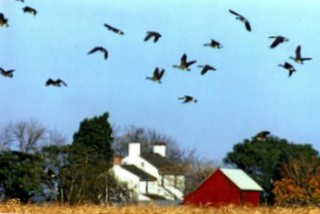 Saveikis recalled how helpful Florio was to him when Saveikis started working as a Fish and Wildlife biologist in 1980. “He was an inspiration who helped me develop as a biologist and conservationist, and I am honored to share this special day with Tony and his family,” Saveikis said.
Saveikis recalled how helpful Florio was to him when Saveikis started working as a Fish and Wildlife biologist in 1980. “He was an inspiration who helped me develop as a biologist and conservationist, and I am honored to share this special day with Tony and his family,” Saveikis said.
Florio thanked the friends, family, and co-workers at the ceremony and remembered those who have passed away. “Very few people have had a career so personally rewarding. I’ve been blessed. So many people have been so helpful to me through the years,” said Florio.
Florio received tributes from the Delaware Senate, presented by Sen. Bruce Ennis; from the State House of Representatives, presented by Rep. Harvey Kenton and Rep. David Wilson on behalf of Rep. Bill Carson; and from Gov. Jack Markell and Lt. Gov. Matt Denn, read by DNREC Deputy Secretary Small.
The idea for naming the wildlife area in honor of Florio came from Wayne Lehman, Division of Fish and Wildlife regional manager. Early in his career, Lehman worked with Florio.
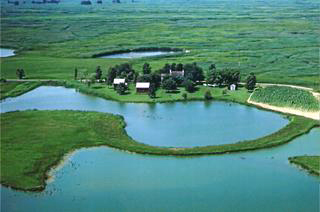 “I was inspired by all the work he had done,” said Lehman. “Tony was a great conservationist, and I thought this would be a fitting way to honor his greatness by dedicating this wildlife area in his name.”
“I was inspired by all the work he had done,” said Lehman. “Tony was a great conservationist, and I thought this would be a fitting way to honor his greatness by dedicating this wildlife area in his name.”
Also recognized at the ceremony was Joanna Wilson, DNREC Public Affairs spokeswoman, for all of her work in the naming process and in organizing the ceremony.
How Florio’s career began
Originally from Orange, Conn., Florio was an undergraduate studying forestry at the University of Connecticut when he began working on a grouse census project with a Connecticut wildlife technician named Norman Wilder. In 1948, Wilder was chosen as director of the Delaware Board of Game and Fish Commissioners’ Conservation Division. His first hire was the newly-graduated Florio in January 1949. In 1957, Wilder became the first director of Delaware’s fledgling fish and wildlife agency, today known as the Delaware Division of Fish and Wildlife.
“Norman Wilder took me under his wing and was my mentor, my guidepost, and many times, my salvation,” said Florio. Florio wrote an Outdoor Delaware article in 2011 celebrating the 100th anniversary of fish and wildlife conservation, recalling Wilder’s accomplishments during the 22 years they worked together.
“Under Norman’s leadership, the mold was created that would produce the long-term shape of fish and wildlife management in Delaware,” Florio wrote. “His was a far-sighted vision, and spot-on, especially with regard to wetlands, the heart and soul of the magnificent Delaware estuary.”
In August 1954, Florio and his new wife, Patricia, settled into the Sutton House, located on the first tract of the Woodland Beach Wildlife Area east of Smyrna, which had been purchased by the state in 1953. They would live in the 18th century brick house for 32 years and raise their three children in “splendiferous isolation” there, surrounded by scenic waters and marshland in the heart of Delaware’s Bayshore Region. Florio and his family became widely known in the fish and wildlife conservation community for their stewardship, which frequently included rehabilitating numerous species of juvenile and injured wildlife.
“Pat cheerfully put up with all my faults and foibles,” said Florio, who added that living in the Sutton House presented many challenges, from frequent power outages and occasional lack of heat inside, to the muddy roads and bothersome insects outside.
“There’s no way I can ever convey my everlasting love and gratitude to her,” said Florio, who also talked about how proud he and his wife are of their three children, Roger, Gwen, and Kathleen.
Accomplishments and milestones
Florio began his fish and wildlife career as a wildlife technician doing fieldwork and mapping newly-acquired state wildlife lands and new ponds. He was especially involved in developing waterfowl and mosquito impoundments at Woodland Beach, Little Creek, Ted Harvey, and Assawoman wildlife areas, as well as many waterfowl ponds on public and private lands.
As an artist, photographer and writer, Florio illustrated calendars and became a frequent contributor to the agency’s magazine, the Delaware Conservationist, first published in 1957 and continuing today as Outdoor Delaware. Florio finished his long career as Delaware’s Wildlife Section administrator with the Division of Fish and Wildlife, retiring in 1986.
During Florio’s 37 years of state service there were many milestones. In 1970, the Delaware Board of Game and Fish Commission became the Division of Fish and Wildlife as part of Governor Russell W. Peterson’s newly organized Delaware Department of Natural Resources and Environmental Control. In 1971, Governor Peterson’s landmark Coastal Zone Act passed into law and continues to protect the state’s coastal areas. Having gained support from federal and state funding, as well as private partners such as Delaware Wild Lands, wildlife lands statewide grew to encompass more than 60,000 acres, with public hunting and access areas, boat launches and fishing piers. And the foundations were laid for many of today’s programs that help conserve Delaware’s natural resources, from the Waterfowl and Trout Stamp programs to the highly successful project to restore the state’s wild turkey population.
As for the wildlife area that now carries Florio’s name, Woodland Beach Wildlife Area today has grown to 6,320 acres and includes three major tracts: the main tract, McKay Tract and Matarese Tract. Its amenities and attractions include a 60-acre waterfowl refuge; fishing and crabbing from the pier that extends from the town center of Woodland Beach on the Delaware Bay; a 1.5-mile nature trail; and the Aquatic Resources Education Center (AREC) for students and teachers, which includes three catch-and-release stocked fishing ponds and a 940-foot boardwalk interpretive trail over tidal marshlands behind the center.
In retirement, an author and traveler
Following his retirement, with the encouragement of June Sayers of the Smyrna Clayton Heritage Association, Florio wrote, illustrated and published “Progger: A Life on the Marsh,” a memoir of his Woodland Beach years that includes a slice of the area’s rich history.
He and Pat now make their home part of the year in Vermont, and travel extensively. Their travels include frequent visits to Delaware, where they always make sure to travel along the Bayshore’s most scenic byway – Route 9, which was for so many years their road home, and which remains a pleasure and inspiration.
“The Delaware Estuary is second to none, and to know that the path forged by Norman Wilder is today being traveled with increasing vigilance gives me much satisfaction,” Florio said. “Certainly there have been and will be hiccups along the way – but my optimism for the future lies in my admiration and confidence in the new generation of conservationists, who will, in my firm belief, find the path that leads to both economic and environmental success.”
Patricia Florio: Memories of living at the Woodland Beach Wildlife Area
Spring 1954: I was twenty years old and in love with a wonderful man, who confirmed his love for me with a marriage proposal. My fiancée’s boss, Norman Wilder, proposed fixing up the old… circa 1730…house on the property the Game & Fish Commission had recently acquired, which would be the refuge headquarters and our home. Under Tony’s guidance the approx. 6000 acres of marsh and fast land would become a waterfowl refuge and hunting area.
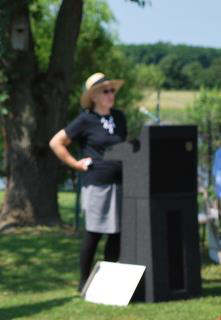 On a beautiful spring day I was introduced to the few hundred acres of the area’s upland. At the end of a half-mile long, dirt road sat the Sutton House, a.k.a. the Bickley estate, a two-story brick dwelling with broken windows, no floor in one of the downstairs rooms, no plumbing, heating or electricity. Three outbuildings…a sturdy square building, a barn with attached shed and a smokehouse… completed the picture.
On a beautiful spring day I was introduced to the few hundred acres of the area’s upland. At the end of a half-mile long, dirt road sat the Sutton House, a.k.a. the Bickley estate, a two-story brick dwelling with broken windows, no floor in one of the downstairs rooms, no plumbing, heating or electricity. Three outbuildings…a sturdy square building, a barn with attached shed and a smokehouse… completed the picture.
For me ‘twas love at first sight!
Making the house livable was an odyssey in itself, with the necessary changes not quite completed when we returned from our August honeymoon to Canada’s Gaspe Peninsula. Two months later hurricane Hazel arrived, doing considerable damage to Delaware but, thankfully, little to the staid old house which, over 200+ years, had certainly weathered many storms.
Prior to that storm a black Labrador retriever puppy we dubbed “Kathleen Mavourneen” joined us at the Woodland Beach Wildlife Area. The following summer daughter Gwen was born, followed by son Roger. Our last child, Kathleen, who often announced she was not named after a dog, completed our family.
Some of the storms we experienced were memorable. During our early years at the Refuge electric outages were fairly frequent. No electricity meant we had no running water or working stove. Also no heat, other than what the seven foot wide kitchen fireplace could provide.
Getting snowed in was just part of winter. Our longest housebound spell lasted a week, again without electricity & all the comforts that provided. The writings of James Whitcomb Riley became the family favorite during such times. Hurricanes Diane and Hazel, an unusually strong storm-at-sea or even extra high winds coinciding with full moon tides, meant the house was literally surrounded by water. One receding tide left fish flopping in the lane. Daughter Kathleen, walking from her end-oflane school bus drop-off, ditched her schoolbooks and scooped up a large carp which she proudly carried to the house in her skirt.
During our 32 years living at Woodland Beach, along with many insects (an understatement), we shared our lives with various creatures, some furred, some feathered. Orphaned and/or injured they became part of the household, generally needing…actually demanding…special care, frequently! Usually our temporary guests were named, with many having distinct personalities. The hawks and owls were housed in large cages outdoors while the ‘critters’, i.e. fawns, opossums, raccoons, a woodchuck, skunks, orphaned rabbits, small birds, such as sparrow hawks and even a starling, generally had the run of the house.
One spring, prior to the paving of ‘our’ section of Route 9, grocery shopping became an adventure. After an unusually cold and snowy winter, spring’s freezing and thawing turned the dirt road into a sea of mud. We solved our seasonal travel dilemma by parking the car one and a half miles away on paved Route 6. Tony mounted a new, large garbage can on the back of the tractor. For several weeks my shopping involved driving the tractor to our parked car, then driving the car into Smyrna. The size of the garbage can, not the contents of my wallet, determined the amount of groceries I bought. Returning to our neighbor’s house, I then transferred everything from the car to the garbage can, climbed aboard the tractor and slowly navigated the rutted, slippery road home.
While the fields were planted to soybeans and corn Tony worked at beautifying the area around the house. Eventually over 100 trees were planted along with foundation plantings of flowers and shrubs. My contribution was done in the fall when the Canada geese began to arrive. Each year I planted dozens of daffodil and jonquil bulbs along the lane, from the main road to the house and around the shallow ponds that were installed to attract waterfowl.
The geese and ducks weren’t long in recognizing the shelter those ponds and adjoining fields provided. Their numbers increased dramatically. For several months each year we fell asleep and awoke each morning serenaded by the honks and gabbling of the geese that literally surrounded the house. We quickly adapted to each other’s habits. When I went to the clothesline the birds simply moved aside, making a corridor for me. They also moved aside when our son needed space to noisily bang a basketball into a hoop mounted on the barn.
For many years Tony’s office and drawing board were in the house with ‘office hours’, it seemed, any time! Weekends were especially busy. Early morning and late night phone calls were part of the routine…folks asking about the times of high or low tide, hunting regulations¸ birding identification, etc. For a few years the Game and Fish radio’s base station was housed in the kitchen. During the opening days of the various hunting seasons our meals were rather sketchy as the radio and telephone calls were practically non-stop.
Over the years waterfowl and vehicular traffic increased. Eventually Route 9, formerly a half or 9 foot road, was completely paved, as was the lane to the house which remained the area’s headquarters. In time snow geese were no longer a ‘new attraction’. The flower bulbs bloomed; the shrubs and trees grew…and the years whizzed by. After 32 years it was time to move on, literally and figuratively; however the memories of our time in the Sutton House on the Woodland Beach Wildlife Area remain.
Pat
Tony Florio Woodland Beach Wildlife Area dedication on 23 June, 2014
Good morning…
To those distinguished members of the Legislature present; to the members of DNREC; to those, like myself, retired State of Delaware employees; to the member of various councils present; our guests……and family.
 You know, probably very few people have had a career which has been so personally re-
You know, probably very few people have had a career which has been so personally re-
warding as that with which I’ve been blessed.
Over the years there have been so many people who have helped me in various and sundry ways, that it would be impossible to sort them all out. However, I would like to enumerate a few who have, through the years, provided the sustenance which allows one to proceed.
First and foremost, Norman Wilder, who took me under his wing as an undergraduate at UCONN: he brought me to Delaware and really was my mentor, my guidepost and, on at least one occasion, my salvation.. He literally brought an as yet unmarried Patricia and me out to this very house, some 60 years ago, asking us if, following our impending marriage, we would like to live here.
To Patricia, my wife of nearly 60 years , who moved into the Sutton House as a new bride, who has cheerfully put up with all my faults and foibles; mosquitoes; greenheads;
sheep-flies; no-see-ums; hurricanes and lightning strikes; roads that, at times, would put to shame a Vermont mud season. To her perseverance and uncommon common sense, there is no way I could ever hope to convey my everlasting love and gratitude.
To our children; Gwen, Roger and Kathleen…..well, few offspring could have provided their parents with more admiration and appreciation than you have….and continue to. Thank you.
To my sadly departed alter ego, brother-in-law, hunting companion of over 50 years, the good doctor Pete Piper of Pennsylvania: on many times and places we especially savored sunrises over the cordgrasses behind me, Taylors Gut and numerous other Delaware venues.
Dudley Lunt showed up at the house one day and introduced himself. He had prevailed upon our neighbor Fred Goldsborough to rent a blind on Taylors Gut….that is all it was then, a gut…and Dudley was lucky to scratch a duck or two out of that blind in a season.
Then we (the Fish and Game Department) prevailed upon the Highway Department to impound the gut when they paved Route 9. And Dudley found himself sitting in the “hot tub”!
It was through illustrating Dudley Lunt’s book, “Taylors Gut”, that I met Angus Cameron, senior editor at Knopf in New York. For years Angus had urged me to write a book, but by the time I got around to writing “Progger” Angus had retired and his replacement, of a different bent, declined.
But then, along came June Sayers of Smyrna, who urged me to jointly publish “Progger” with the Smyrna Clayton Heritage Association. Funny how good things happen…
To my field crew; how could one not accomplish good things without the likes of Billy Cook, Joe Heininger, Bobby Knight, Tweety and Howard….just to mention a few.
As it turned out, this was a good…if very singular…environment to raise children in. I do think that Gwen, Roger and Kathy would have no trouble attesting to that.
This event has evoked a sea of sublime memories within me. Your very lovely, familiar faces and places, plus the images of those so dear to me…now gone…have been etched upon my very soul.
Finally I especially want to thank Joanna Wilson, Wayne Lehman and Dave Saveikis, who were so instrumental in making it all possible.
Thank you!

